In-Situ Strain Measurements in Large Volumes of Hardening Epoxy Using Optical Backscatter Reflectometry
Abstract
:1. Introduction
2. Fundamental Principles of Optical Backscatter Reflectometry
3. Experimental Setup
3.1. Strain Measurement Setup
3.2. Temperature Measurement Setup
3.3. Differential Scanning Calorimetry
4. Expected Curing Behavior
5. Results
5.1. Six Stages of Curing
5.2. Strain Development
5.3. Temperature and Degree of Cure Development
6. Discussion
6.1. Six Stages of Curing
- Stage I is obviously the start of the curing reaction. This stage exists directly after the mixing of the components. Even if measurements would be possible it cannot be distinguished from early Stage II measurements. For all practical reasons, it is the OBR zero strain state.
- In Stage II, the epoxy is still liquid and not gelated. Thus, no mechanical strain is acting upon the optical fiber. However, the ongoing exothermic reaction leads to a rising temperature as can be seen in the left graph in Figure 7. This in turn leads to a positive OBR signal which is to be interpreted as temperature and not strain (cf. Figure 4).
- Stage III is the point of gelation. In the temperature measurements, no change in behavior is indicated by reaching this point. However, if the OBR-signal is interpreted as temperature before reaching this point, the OBR values start to deviate from the temperature values determined with independent temperature probes after passing this point. In accordance with the theory, this happens at approximately 60% conversion.
- Stage IV is defined by the still rising temperature due to the ongoing (and probably accelerating) curing reaction.
- Stage V distinguishes itself from the previous stage by the fact that the temperature reaches a maximum and stays at this value. The conversion advances but the chemical reaction is slowing down.
- In Stage VI, the conversion is so high that all ongoing reactions are so slow that just minute amounts of heat are released and the whole regime is governed by the cool down of the sample. For all practical purposes, the epoxy can be seen as “fully cured”.
6.2. Strain Development
6.3. Temperature and Degree of Cure Development
6.4. A Possible Explanation for the Formation of a Strain-Plateau in Large Samples
6.5. General Relevance
7. Conclusions
- The OBR method gives considerably more information than previous point measurements, because it yields the strain along the whole length of the fiber reaching from the edges to the center of the specimen, or wherever the fiber is put.
- The curing strains inside a small and large epoxy block behave differently.
- For small samples, the measured strain along the middle axis of a curing epoxy block behaves as expected from previous studies using other strain measurement methods. The strain profile develops a “bathtub” shape, which is preserved during the cool down of the sample.
- For larger specimens (20 to 60 cm long), curing strains do not show a bathtub-shape but they describe a “W-shape” during the cooling to room temperature. The strain on the sides behaves similar to the known observations from small samples. However, a strain-plateau develops in the middle approximately 5 cm to 8 cm away from the sides that was not identified before. The strains in the plateau region were notably different from the sides of the large specimens and they also did not correspond to strains measured on small samples.
- The thermal shrinkage in the center of large specimens under curing does not behave as expected from measurements of small volumes of epoxy. This is illustrated by the thermal coefficient of expansion being half an order of magnitude smaller above the glass transition temperature compared to below it. The expected behavior is an increase of the thermal expansion coefficient. A possible explanation of this anomaly is that thermal shrinkage under curing in this area is governed by the of the surrounding steel vessel.
8. Ressources
Author Contributions
Funding
Acknowledgments
Conflicts of Interest
Appendix A. Example for the Small Influence of the Temperature on the Strain Measurements

Appendix B. OBR Spatial and Strain Resolution
Appendix C. Calculation of the Conversion at the Point of Gelation
References
- Fischbein, R.A. Method for the determination of the cure shrinkage of epoxy formulations. J. Sci. Instrum. 1966, 43, 480. [Google Scholar] [CrossRef]
- Kinkelaar, M.; Lee, J. Development of a Dilatometer and Its Application to Low-Shrinkage Unsaturated Polyester Resins. J. Appl. Polym. Sci. 1992, 45, 37–50. [Google Scholar] [CrossRef]
- Hill, R.R.; Muzumdar, S.V.; Lee, L.J. Analysis of Volumetric Changes of Unsaturated Polyester Resins During Curing. Polym. Eng. Sci. 1995, 35, 852–859. [Google Scholar]
- Parlevliet, P.P.; Bersee, H.E.N.; Beukers, A. Shrinkage determination of a reactive polymer with volumetric dilatometry. Polym. Test. 2010, 29, 433–439. [Google Scholar] [CrossRef]
- Shah, D.U.; Schubel, P.J. Evaluation of cure shrinkage measurement techniques for thermosetting resins. Polym. Test. 2010, 29, 629–639. [Google Scholar] [CrossRef] [Green Version]
- Plepys, A.R.; Farris, R.J. Evolution of residual stresses in three-dimensionally constrained epoxy resins. Polymer 1990, 31, 1932–1936. [Google Scholar] [CrossRef]
- Merzlyakov, M.; McKenna, G.B.; Simon, S.L. Cure-induced and thermal stresses in a constrained epoxy resin. Compos. Part A Appl. Sci. Manuf. 2006, 37, 585–591. [Google Scholar] [CrossRef]
- Colpo, F.; Humbert, L.; Giaccari, P.; Botsis, J. Characterization of residual strains in an epoxy block using an embedded FBG sensor and the OLCR technique. Compos. Part A Appl. Sci. Manuf. 2006, 37, 652–661. [Google Scholar] [CrossRef]
- Harsch, M.; Karger-Kocsis, J.; Herzog, F. Strain development in a filled epoxy resin curing under constrained and unconstrained conditions as assessed by Fibre Bragg Grating sensors. Express Polym. Lett. 2007, 1, 226–231. [Google Scholar] [CrossRef]
- Karalekas, D.; Schizas, C. Monitoring of solidification induced strains in two resins used in photofabrication. Mater. Des. 2009, 30, 3705–3712. [Google Scholar] [CrossRef]
- Harsch, M.; Karger-Kocsis, J.; Herzog, F.; Fejos, M. Effect of cure regime on internal strain and stress development in a filled epoxy resin assessed by fiber Bragg-grating optical strain and normal force measurements. J. Reinf. Plast. Compos. 2011, 30, 1417–1427. [Google Scholar] [CrossRef]
- Robert, L.; Dusserre, G. Assessment of thermoset cure-induced strains by fiber bragg grating sensor. Polym. Eng. Sci. 2014, 54, 1585–1594. [Google Scholar] [CrossRef]
- Kravchenko, O.G.; Kravchenko, S.G.; Casares, A.; Pipes, R.B. Digital image correlation measurement of resin chemical and thermal shrinkage after gelation. J. Mater. Sci. 2015, 50, 5244–5252. [Google Scholar] [CrossRef]
- Nishimura, T.; Nakagawa, Y. Analysis of Stress Due to Shrinkage in a Hardening Process of Liquid Epoxy Resin. Heat Transf. Asian Res. 2002, 31, 194–211. [Google Scholar] [CrossRef]
- Giaccari, P.; Limberger, H.G.; Salathé, R.P. Local coupling-coefficient characterization in fiber Bragg gratings. Opt. Lett. 2003, 28, 598–600. [Google Scholar] [CrossRef] [PubMed]
- Bernasconi, A.; Carboni, M.; Comolli, L.; Galeazzi, R.; Gianneo, A.; Kharshiduzzaman, M. Fatigue Crack Growth Monitoring in Composite Bonded Lap Joints by a Distributed Fibre Optic Sensing System and Comparison with Ultrasonic Testing. J. Adhes. 2016, 92, 739–757. [Google Scholar] [CrossRef]
- Soller, B.J.; Gifford, D.K.; Wolfe, M.S.; Froggatt, M.E. High resolution optical frequency domain reflectometry for characterization of components and assemblies. Opt. Express 2005, 13, 666–674. [Google Scholar] [CrossRef] [PubMed]
- Bao, X.; Chen, L. Recent Progress in Brillouin Scattering Based Fiber Sensors. Sensors 2011, 11, 4152–4187. [Google Scholar] [CrossRef] [PubMed] [Green Version]
- Bao, X.; Huang, C.; Zeng, X.; Arcand, A.; Sullivan, P. Simultaneous strain and temperature monitoring of the composite cure with a Brillouin-scattering-based distributed sensor. Opt. Eng. 2002, 41, 1496–1501. [Google Scholar] [CrossRef]
- Ramakrishnan, M.; Rajan, G.; Semenova, Y.; Farrell, G. Overview of Fiber Optic Sensor Technologies for Strain/Temperature Sensing Applications in Composite Materials. Sensors 2016, 16, 99. [Google Scholar] [CrossRef] [PubMed]
- Uchida, S.; Levenberg, E.; Klar, A. On-specimen strain measurement with fiber optic distributed sensing. Measurement 2015, 60, 104–113. [Google Scholar] [CrossRef]
- Henault, J.M.; Quiertant, M.; Delepine-Lesoille, S.; Salin, J.; Moreau, G.; Taillade, F.; Benzarti, K. Quantitative strain measurement and crack detection in RC structures using a truly distributed fiber optic sensing system. Constr. Build. Mater. 2012, 37, 916–923. [Google Scholar] [CrossRef]
- Villalba, S.; Casas, J.R. Application of optical fiber distributed sensing to health monitoring of concrete structures. Mech. Syst. Signal Process. 2013, 39, 441–451. [Google Scholar] [CrossRef]
- Rodríguez, G.; Casas, J.R.; Villaba, S. Cracking assessment in concrete structures by distributed optical fiber. Smart Mater. Struct. 2015, 24, 035005. [Google Scholar] [CrossRef] [Green Version]
- Samiec, D. Distributed fibre-optic temperature and strain measurement with extremely high spatial resolution. Photonik Int. 2012, 10–13. [Google Scholar]
- Froggatt, M.; Moore, J. High-spatial-resolution distributed strain measurement in optical fiber with Rayleigh scatter. Appl. Opt. 1998, 37, 1735–1740. [Google Scholar] [CrossRef] [PubMed]
- Kreger, S.T.; Gifford, D.K.; Froggatt, M.E.; Soller, B.J.; Wolfe, M.S. High Resolution Distributed Strain or Temperature Measurements in Single- and Multi-mode Fiber Using Swept-Wavelength Interferometry. Opt. Soc. Am. 2006. [Google Scholar] [CrossRef]
- Sanborn, E.E.; Sang, A.K.; Wesson, E.; Wigent, D.E.; Lucier, G. Distributed Fiber Optic Strain Measurement Using Rayleigh Scatter in Composite Structures. Exp. Appl. Mech. 2011, 6, 461–470. [Google Scholar]
- Heinze, S.; Echtermeyer, A.T. A Running Reference Analysis Method to Greatly Improve Optical Backscatter Reflectometry Strain Data from Inside Hardening and Shrinking Materials. Appl. Sci. 2018, 8, 1137. [Google Scholar] [CrossRef]
- Hexion. Datasheet—EPIKOTE Resin MGS RIMR 135 and EPIKURE Curing Agent MGS RIMH 134-RIMH 13, 2006. Available online: http://www.hexion.com/en-US/product/--archive--epikote-resin-mgs-rimr135-and-epikure-curing-agent-mgs-rimh134-rimh1366-rimh137-rimh138 (accessed on 22 May 2018).
- Krauklis, A.; Norwegian University of Science and Technology, NTNU, Department of Mechanical and Industrial Engineering, Trondheim, Norway. Personal communication, 2018.
- Grave, J.H.L.; Håheim, M.L.; Echtermeyer, A.T. Measuring changing strain fields in composites with Distributed Fiber- Optic Sensing using the optical backscatter reflectometer. Compos. Part B Eng. 2015, 74, 138–146. [Google Scholar] [CrossRef]
- Grave, J.H.L.; Echtermeyer, A.T. Strain fields in adhesively bonded patch repairs of damaged Metallic beams. Polym. Test. 2015, 48, 50–58. [Google Scholar] [CrossRef]
- Lee, D.G.; Kim, B.C. Investigation of coating failure on the surface of a water ballast tank of an oil tanker. J. Adhes. Sci. Technol. 2005, 19, 879–908. [Google Scholar] [CrossRef]
- Sulaiman, S.; Brick, C.M.; De Sana, C.M.; Katzenstein, J.M.; Laine, R.M.; Basheer, R.A. Tailoring the global properties of nanocomposites. Epoxy resins with very low coefficients of thermal expansion. Macromolecules 2006, 39, 5167–5169. [Google Scholar] [CrossRef]
- Nielsen, M.W.; Schmidt, J.W.; Hattel, J.H.; Andersen, T.L.; Markussen, C.M. In situ measurement using FBGs of process-induced strains during curing of thick glass/epoxy laminate plate: experimental results and numerical modelling. Wind Energy 2013, 16, 1241–1257. [Google Scholar]
- Dong, K.; Zhang, J.; Cao, M.; Wang, M.; Gu, B.; Sun, B. A mesoscale study of thermal expansion behaviors of epoxy resin and carbon fiber/epoxy unidirectional composites based on periodic temperature and displacement boundary conditions. Polym. Test. 2016, 55, 44–60. [Google Scholar] [CrossRef]
- Chun, H.; Kim, Y.J.; Tak, S.Y.; Park, S.Y.; Park, S.J.; Oh, C.H. Preparation of ultra-low CTE epoxy composite using the new alkoxysilyl-functionalized bisphenol A epoxy resin. Polymer 2018, 135, 241–250. [Google Scholar] [CrossRef]
- Landa, V.A.; Stepnov, E.M.; Kupalova, I.K. Partial coffficients of thermal expansion of high-speed steels. Metal Sci. Heat Treat. 1971, 13, 675–677. [Google Scholar] [CrossRef]
- Den’gin, I.N.; Mironenko, V.V.; Kondrenko, A.I. Determining the coefficients of linear thermal expansion of a 08sp steel and CCh 18-36 cast iron bimetal. Chem. Pet. Eng. 1978, 14, 252–253. [Google Scholar] [CrossRef]
- Fernandes, C.M.; Rocha, A.; Cardoso, J.P.; Bastos, A.C.; Soares, E.; Sacramento, J.; Ferreira, M.G.S.; Senos, A.M.R. WC-stainless steel hardmetals. Int. J. Refract. Met. Hard Mater. 2018, 72, 21–26. [Google Scholar] [CrossRef]
- Data and Software Used to Obtain the Data Presented in This Article. Available online: https://doi.org/10.5281/zenodo.1228686 (accessed on 22 May 2018).
- Software Used to Obtain the Data for This Article Can be Found under. Available online: https://github.com/andsearchtherefor’OBR-Running-Reference-Method-Software’ (accessed on 22 May 2018).
- GNU General Public License. Available online: http://www.gnu.org/licenses/gpl.html (accessed on 22 May 2018).
- Medhat, M.; El-Zaiat, S.Y.; Radi, A.; Omar, M.F. Application of fringes of equal chromatic order for investigating the effect of temperature on optical parameters of a GRIN optical fibre. J. Opt. A Pure Appl. Opt. 2002, 4, 174–179. [Google Scholar] [CrossRef]
- Odian, G. Principles of Polymerization, 4th ed.; John Wiley & Sons: New York, NY, USA, 2004. [Google Scholar]

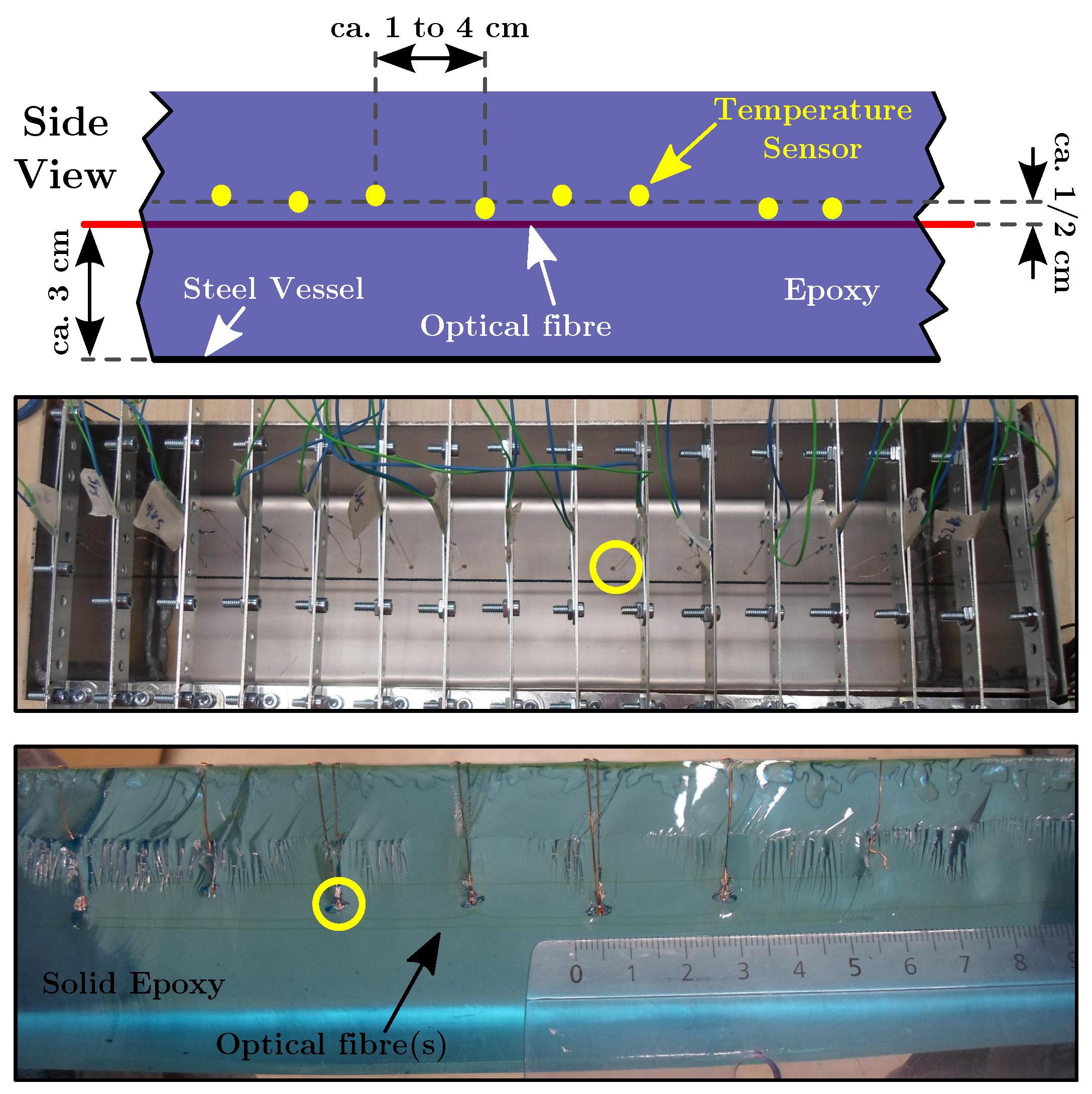
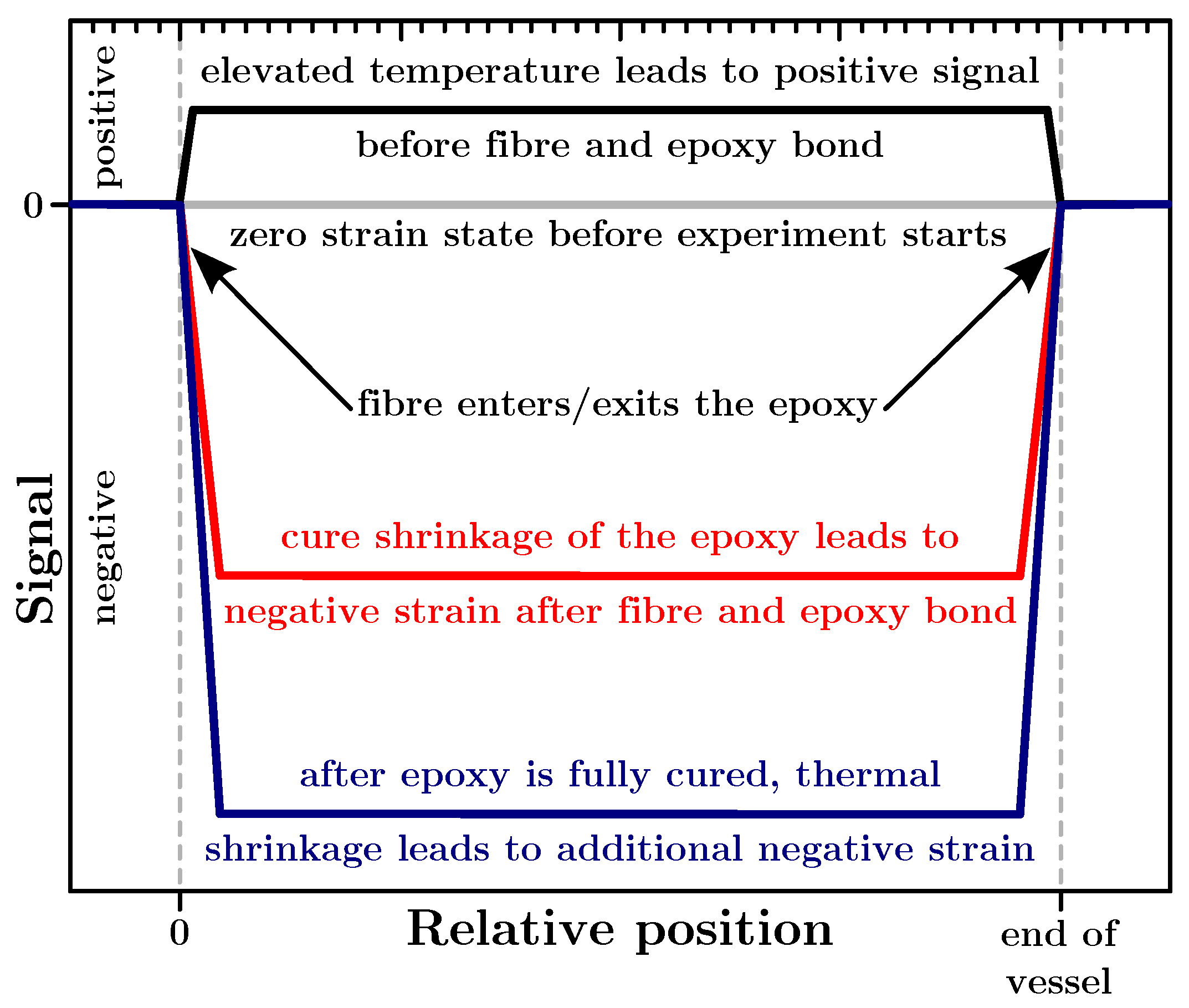
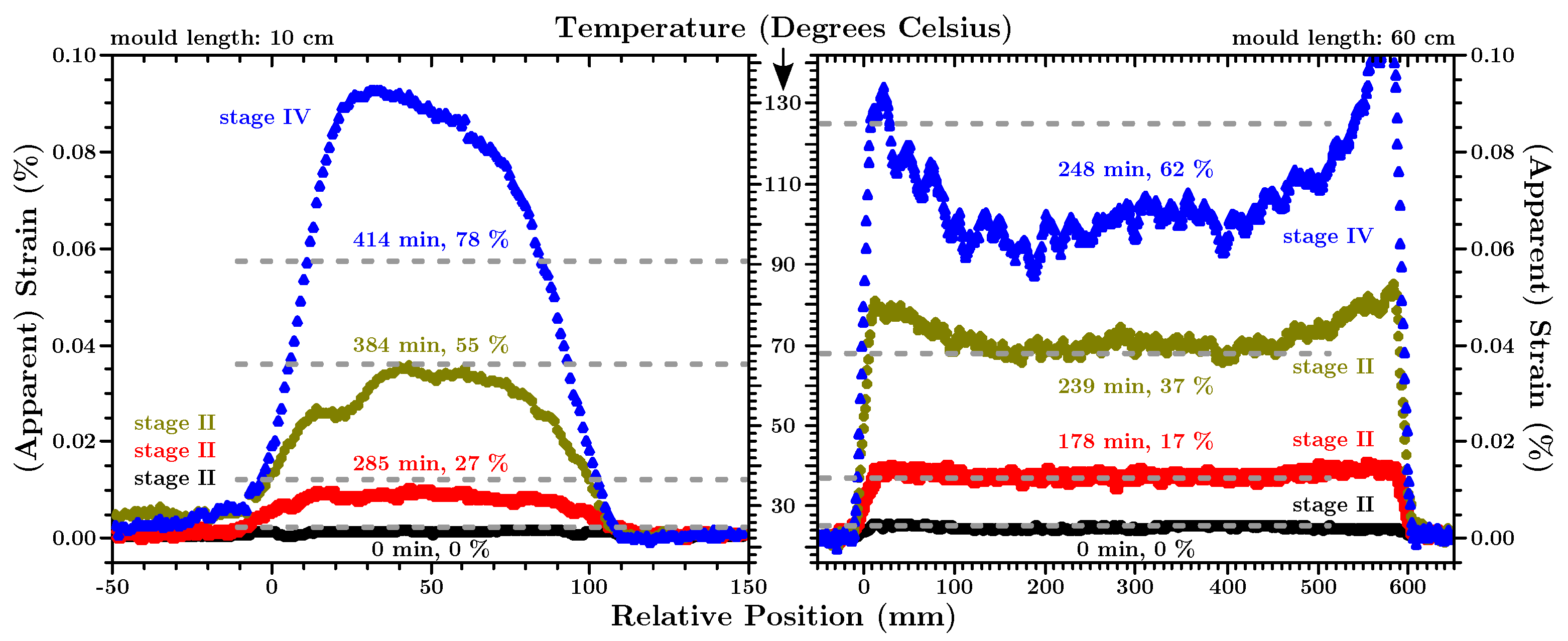
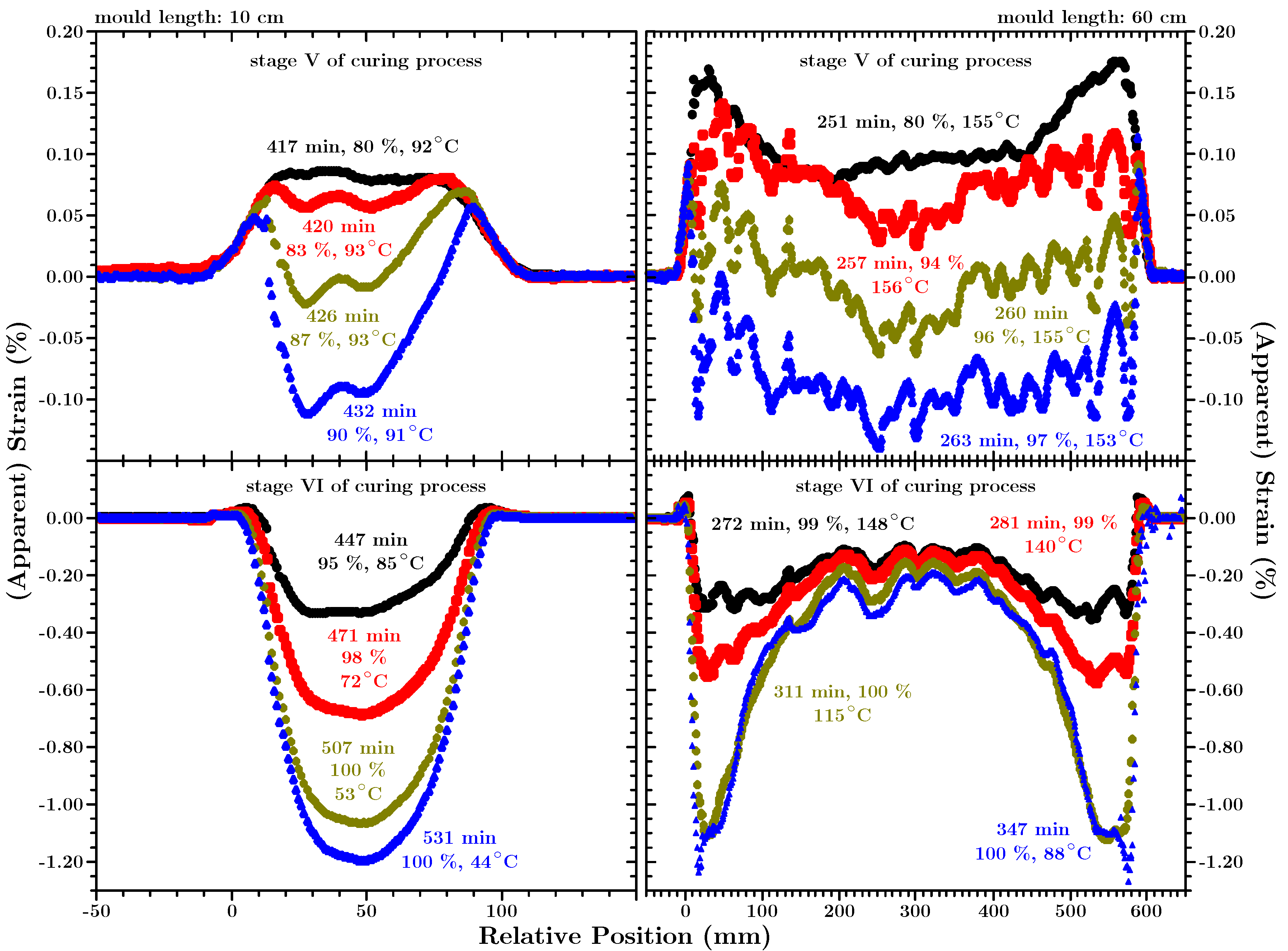
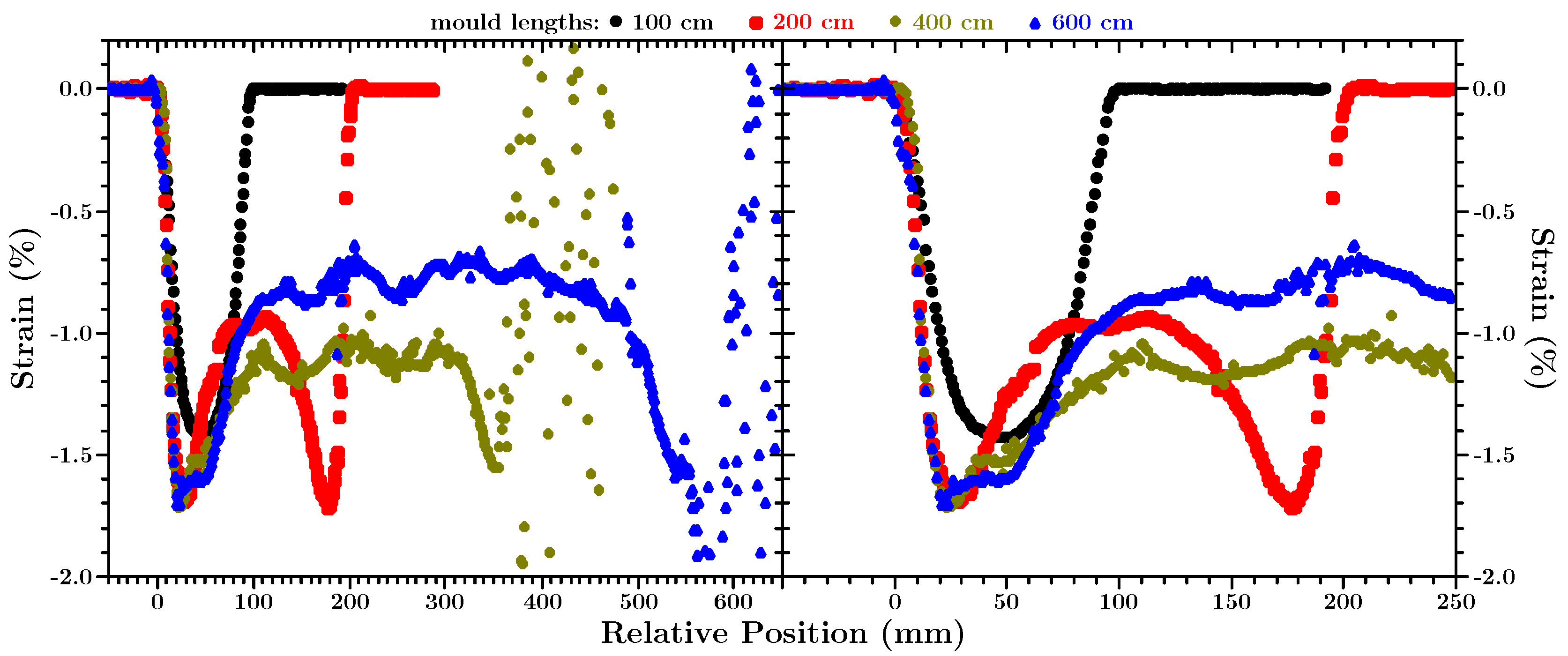
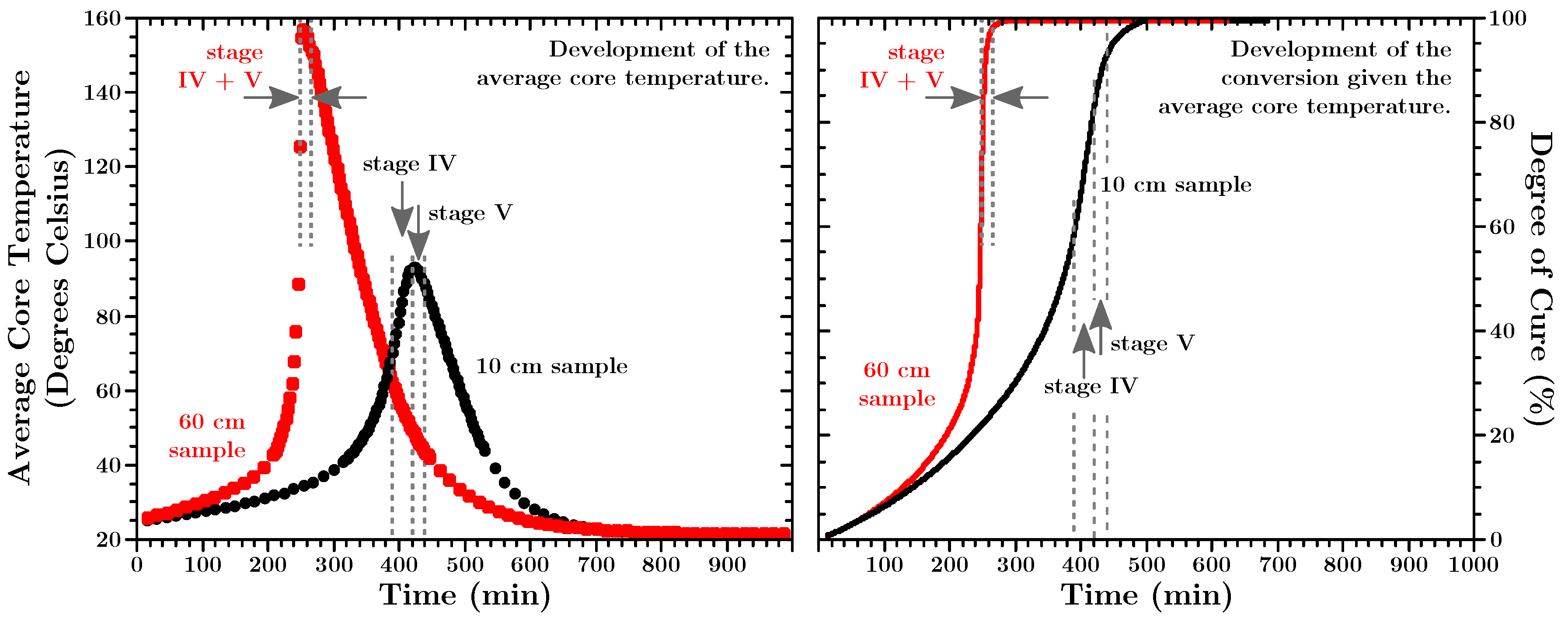


| Dimensions (l·w·h, ) | Mass of Epoxy | No. & Position of Temperature Probes | Comments |
|---|---|---|---|
| 0.6 kg | 5, random position | ||
| Different width to keep the amount | |||
| 2.6 kg | 5, random position | of epoxy the same as for the 40 cm | |
| mold at constant filling height. | |||
| 2.6 kg | 16, aligned above fiber | distance between probes: 2–3 cm | |
| 3.9 kg | 24, aligned above fiber | distance between probes: 1–3 cm |
| Stage | Short Description | Bonding to Optical Fiber | OBR Signal | Degree of Cure |
|---|---|---|---|---|
| I | Start | no | temperature | liquid |
| II | First Curing | no | (rising) temperature | increases |
| III | Gelation | yes | strain and temperature | ≈60% |
| IV | Further Curing | yes | strain and temperature | up to ≈80% |
| V | Thermal Equilibrium | yes | strain and temperature | ≈80–95% |
| VI | Cool down | yes | strain and temperature | >95% |
| Stage | Cure Shrinkage | Thermal Expansion/Shrinkage | Temperature | Heat Created |
| I | not relevant | not relevant | room temperature | yes |
| II | not relevant | not relevant | increases | yes |
| III | becomes relevant | becomes relevant | “gelation temperature” | yes |
| IV | yes | expansion | increases to maximum | yes |
| V | yes | no | maximum temperature | no |
| VI | no | shrinkage | cooling to room temperature | no |
| Mold Length | 1st Gradient Slope | Length of Valley | Minimum Strain | 2nd Gradient Slope | 2nd Gradient Length | Plateau Mean-Strain Value |
|---|---|---|---|---|---|---|
| 10 cm | −0.061%/mm | - | −1.43% | - | - | −1.41% |
| 20 cm | −0.111%/mm | 15 mm | −1.69% | +0.018%/mm | 35 mm | −0.97% |
| 40 cm | −0.142%/mm | 35 mm | −1.71% | +0.008%/mm | 50 mm | −1.11% |
| 60 cm | −0.099%/mm | 35 mm | −1.70% | +0.016%/mm | 50 mm | −0.80% |
© 2018 by the authors. Licensee MDPI, Basel, Switzerland. This article is an open access article distributed under the terms and conditions of the Creative Commons Attribution (CC BY) license (http://creativecommons.org/licenses/by/4.0/).
Share and Cite
Heinze, S.; Echtermeyer, A.T. In-Situ Strain Measurements in Large Volumes of Hardening Epoxy Using Optical Backscatter Reflectometry. Appl. Sci. 2018, 8, 1141. https://doi.org/10.3390/app8071141
Heinze S, Echtermeyer AT. In-Situ Strain Measurements in Large Volumes of Hardening Epoxy Using Optical Backscatter Reflectometry. Applied Sciences. 2018; 8(7):1141. https://doi.org/10.3390/app8071141
Chicago/Turabian StyleHeinze, Søren, and Andreas T. Echtermeyer. 2018. "In-Situ Strain Measurements in Large Volumes of Hardening Epoxy Using Optical Backscatter Reflectometry" Applied Sciences 8, no. 7: 1141. https://doi.org/10.3390/app8071141




